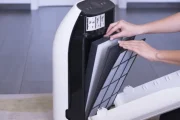Air purifiers are devices that remove contaminants from a given area. Pollen is not an exception. Pollen is a substance composed of pollen grains, which are produced by the anthers of seed-bearing plants. While the flowers are beautiful to our eyes, the pollen found inside our homes may trigger miserable allergy symptoms, making it difficult to enjoy time at home. You may want to know, “Do air purifiers remove pollen?” In this post, we will help you know how air purifiers can remove pollen from the air.
Note: If you need answers to common questions about air purifiers, please read our air purifier FAQs.
Related posts:
Do air purifiers remove pollen?
Air purifiers are the best way to remove pollen, as well as allergies symptoms related to pollen. The air purifiers use various of air filter types to capture even the tiniest particles. The efficiency of an air purifier can as high as 99.97% of down to 0.3 microns airborne pollutant particles. The tiniest pollen particle is just 3 microns in size, so it can’t escape the air filter of a residential air purifier.
There are two popular air filters to help the air purifiers remove pollen from the air. They are:
- HEPA filter. The HEPA filter (especially the True HEPA filter) is made of highly dense paper through a combination of the following three mechanisms: First, the pollen particles (which are 10 times bigger than the smallest particles) follow a line of flow in the air stream and come within one radius of a fiber and adhere to it, which is called “interception.” The pollen is then forced to embed in one of the fibers by the higher air flow velocity in the next step, called impaction. You don’t even need to know the diffusion step, as the pollen is in fact larger than the 0.3-micron microscopic particles and can’t escape the first two steps of the HEPA filter.
- Ionic filter, or ionizer. This air filter is an advanced air cleaning technology that emits a cloud of negatively charged ions into the air. The contaminants (including pollen) will be electrostatically attracted to another physical filter.
If you need to find an air purifier to remove the pollen, you need to search for these two air filters. The 0.3-micron size of microscopic particles is far smaller than even the smallest pollen, so I assure you that an air purifier can help you out of pollen allergies easily.
Most air purifiers reviewed on Breathe Quality come with a true HEPA filter, like this Rabbit Air MinusA2, which guarantees to defeat not only pollen but also any allergen factors like mold, fungi, pet dander, dust, etc.
List of the best air purifiers
- 1, Best Air Purifiers (Air Purifier Ranking List)
- 2, Best Air Purifiers for Allergies and Asthma
- 3, Best Air Purifiers for Bedroom
- 4, Best Air Purifiers for Baby
- 5, Best Air Purifiers for Smoke
- 6, Best Air Purifiers for Dust
- 7, Best Air Purifiers for Mold
- 8, Best Large Room Air Purifiers
- 9, Best Air Purifiers for Pets
- 10, Best Air Purifiers for Office
Other ways to remove pollen
Also, the pollen can be found anywhere in your home. Finding an efficient way to eliminate this pollen can be a challenge. The best method to remove pollen is by using an air purifier, but along with that, these tips may help create an effective solution for your home.
1. Use dry cleaning fabric
Dry cleaning fabric is also an excellent way to remove pollen from your furniture. Liquid fabric softener can also be used to achieve the same results.
2. Soak in the cold water
For people with airborne pollen in their clothes, they can rinse the stained area with cold water, running the water through the back of the fabric. If the stain remains, soak the clothing in cold water for 30 minutes.
3. Apply stain remover
Another method to remove pollen stains is by applying a laundry stain remover (stick, spray, or gel). Washing the garment in hot water is recommended. Hot water will help remove the stain better, but be careful when you apply too much heat to your clothes; they may be damaged or faded.
Most common sources of airborne pollen
Pollen is a problem from outdoors to our office, cars, and, of course, our homes. It is the male microgametophytes (one of the two alternating phases of the life cycle of plants) of seed plants that are primarily dispersed by insects or wing.
Wind-pollinated pollen is called anemophilous, while insect-pollinated pollen is called entimophilous.
While insect-pollinated pollen has a high nutritional value (source: Wikipedia), wind-pollinated pollen can cause allergy symptoms in pollen-sensitive individuals.It is carried by the wind rather than by insects and has a much lower nutritional value.
Such plants can produce large quantities of lightweight pollen, which can be carried great distances thanks to wind dispersal. The outcome is that people inhale the pollen and get a nasal allergy.
Nasal allergies to pollen are called pollinosis, and an allergy specifically to grass pollen is called hay fever.
Pollen may seem relatively harmless, but it can be harmful to your respiratory system. The lungs are the body’s natural defense mechanism, as they remove pollen particles from the respiratory system. However, when exposed to high levels of pollen, people could easily suffer from allergies. That is why you need to keep your windows closed or buy an air purifier to help remove the airborne pollen.
Rating Breathe Quality
-
Average ratings for this post



